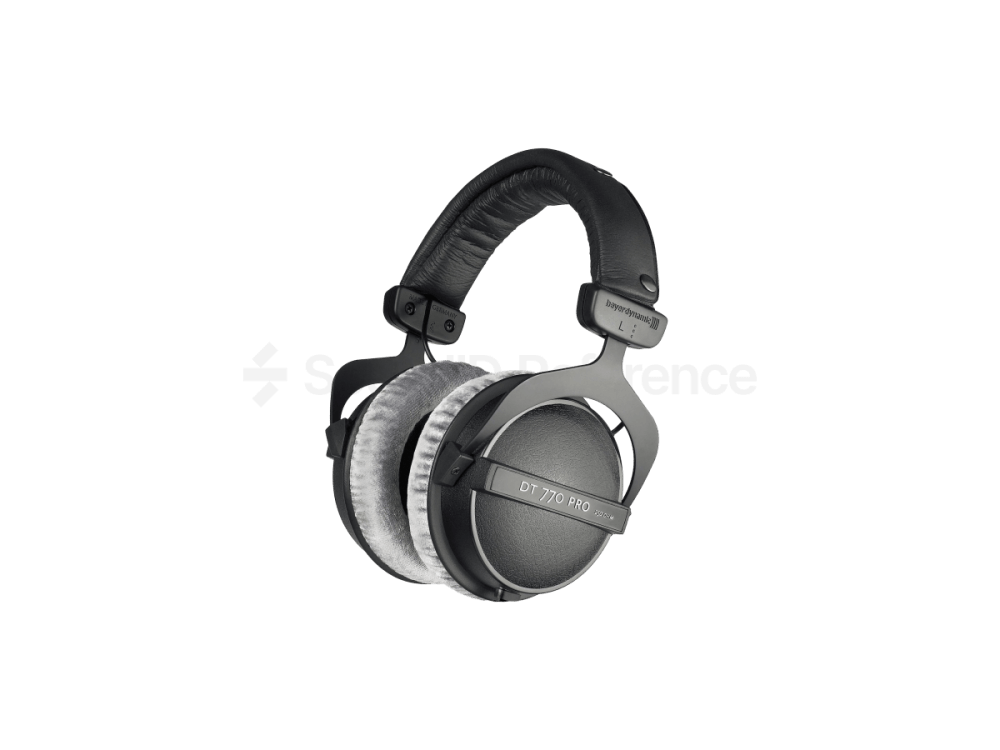Beyerdynamic DT770 Pro 250 Ohm – A Studio Staple
The DT 770 Pro has been around for a while and generally has found itself in many control rooms. It has many of the features one would look for in a monitor headphone – closed-back, over-ear design with Beyerdynamic reputation behind it. So, let’s see if the DT 770 Pro 250 Ohm still has what it takes to be the go-to closed back for studios.
- Priced reasonably
- Feels sturdy and like they would last
Pros list with SoundID Reference calibration
- Neutral frequency response, overall THD is still within reason
- Rather top-end heavy sound signature
- The cable cannot be replaced
- Hard to drive out of a laptop headphone out
- Plastic used on the headphones feels a bit cheap
Yes, they do require an amp or audio interface to be run at louder volumes. The story with the DT 770 Pro’s just like with their cousins, the DT 880 Pro and DT 990 Pro. Even though their nominal impedance is lower than that of Sennheiser HD 650, they are a tad less sensitive, hence will require a bit more power.
Even though the construction is sturdy and the headband feels like it could last a good few years of extensive use, the overall feel is slightly on the cheaper side due to the use of brutal-looking plastic for the ear-cups and headband adjustment mechanism. Almost all parts are replaceable and easily available from Beyerdynamic. Unfortunately, that one part that’s most likely to fail first, the cable, is non-detachable. If that gives out, you’re missing a session or two until someone resolders the cable. On the other hand, the ear pads can be replaced and even swapped to pleather for more isolation but a bit less comfort. Do keep in mind that this alters both the aesthetics and sound of the DT 770 Pro.
The DT 770 Pro carries on the trend of what we call a “typical Beyer sound” – a very decent bass response followed by a carved-out midrange, topped off with an odd bump going all the way from 3.5kHz to 9kHz. This means that you’ll get too much focus on the details like cymbals and vocal presence, leaving out all important midrange character, especially when listening to something with guitars in the mix. Also, they can induce ear fatigue pretty quickly. However, we do see the benefit of this in live sound applications where you really want to get all of the top end under control to avoid a feedback loop which can be a quick showstopper.
The DT 770 Pro has an OK balance between Left and Right channels. Even though this model doesn’t have weird dips or peaks in one of the channels, the stereo image is still a bit skewed – differences are throughout the whole frequency spectrum. Luckily the bigger differences are mostly isolated in a very narrow area and aren’t too noticeable.
It’s a decent 8 in our books! They stay tightly on your head, without pressing on your skull to keep them in place. The headband adjustment could be smoother – a quick adjustment while keeping them on your head can be quite a challenge. Other than that – DT 770 Pro is very comfortable to wear even for a longer period of time and that is mostly due to the fact that the ear pads are large enough to go around your ears and not press against them.
At this price point, which at the time of writing is 139€/159$, the market is rather saturated with options left and right. This model will give the rest of the competition a bit of a run for their money in terms of comfort, possible longevity, and sound isolation due to their construction, although, sound-wise there are better options out there.
Typical for a dynamic headphone from the nineties, the driver will distort once it goes into high excursion due to low frequency content or high SPL. This distortion dips below 1% only at around 105 Hz (when measured at high output levels), and throughout all of this, a nasty 3rd harmonic is very present from 60 Hz to 100 Hz so, when doing anything low-end critical, be careful as this is also present without calibration applied!
The DT 770 Pro overall is a consistent model in terms of translation. The only exception is low-end – for this model, it is very tricky to calibrate. Probably due to their bass reflex system it makes it hard to pinpoint specific problem areas within the bass region that needs to be attenuated thus results from head to head may differ.
How much do they differ pair to pair in terms of frequency response?These headphones are one of the more consistent ones that we’ve measured and even though the difference especially in the bass region can span across ~6 dB, the rest of the spectrum is well within reason. Glad to see a major headphone manufacturer keeping their quality check-up to standard.
Rating
Conclusion
Durable, sits comfortably on the head and most of the parts are replaceable. Top end gets rather harsh and fatigue can set in quickly.
To calibrate your DT 770s, purchase headphone calibration software SoundID Reference or send them in for individual calibration.
For more information about beyerdynamic headphones, continue reading our reviews – DT 240 Pro, DT 770 Pro, DT 900 Pro X, DT 880 Pro, and DT 990 Pro.
Final Rating
Calibration Enabled
Calibration






